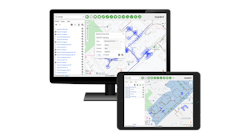Neighborhood-Level Study Reveals 73M Americans Suffer From Digital Distress
By Adie Tomer, Elizabeth Kneebone, and Ranjitha Shivaram
A new report from the Brookings Metropolitan Policy Program finds that although 93% of the nation lives in neighborhoods where 25 Mbps wireline broadband service is available, over 73 million Americans (including 17.7 million children) live in neighborhoods where in-home broadband subscription rates fall below 40%.
The report uses census tract data to reveal neighborhood-level conditions and needs, generating new measures of the Digital Divide in every American community.
The report is released at an important time: the FCC is considering lowering the threshold for broadband speed and service, while Congress is primarily focused on rural gaps. Missed in these debates is the importance of getting all Americans subscribed to in-home broadband.
The US is quickly becoming a digital economy: from how we teach our students, to how workers find employment, to the rise of telecommuters. These subscription gaps present fresh obstacles to enabling all Americans to pursue economic opportunity.
In the report Signs of Digital Distress: Mapping broadband access and subscription in American neighborhoods, we break down both availability and subscription challenges. We find that geography and income levels are the 2 greatest drivers of broadband subscription gaps, perpetuating the Digital Divide in even the most connected metro areas.
Meanwhile, availability is especially inadequate in rural America, where more than half of rural residents lack access to broadband. Yet many large metro areas also don’t enjoy ubiquitous service, leaving many thousands of people without currently-defined broadband.
Why Drill Down?
While most broadband studies report numbers at the national level, studying broadband at a neighborhood level is vital for both policy design and advancing economic opportunity.
As federal, state, and local policymakers pursue universal access to in-home broadband, neighborhood-level indicators confer multiple advantages.
First, broadband infrastructure is not deployed equally within regions, municipalities, and rural counties. Identifying these gaps can help target policies to boost availability.
Second, understanding how neighborhood-level subscription varies enables policymakers and practitioners to more effectively target their limited resources to boost adoption among populations and neighborhoods most in need. (In this analysis, neighborhoods are approximated by census tracts. For more information on this and other methodological details, please download the full report: https://www.brookings.edu/wp-content/uploads/2017/09/broadbandreport_september2017.pdf)
Neighborhood-level broadband conditions can indicate which neighborhoods are most likely to be left behind in a digital era. Chicago’s multiyear Smart Communities program — which offered digital literacy and other training in targeted, low-income neighborhoods — proved that more residents will access job and health care services when they receive a neighborhood-wide intervention to promote broadband use. These promising results suggest that getting entire neighborhoods online can lead to greater economic outcomes, but they also confirm that neighborhoods struggling with broadband subscription are important focus areas for inclusive economic development planning.
Just as importantly, this research confirms the need to further study neighborhood effects related to broadband deployment and subscription. Much like groundbreaking work under concentrated poverty and general access to economic opportunity based on where people live, neighborhood broadband conditions may have significant spillovers that impact the entire population in those neighborhoods and even the broader region.
National statistics on the extent to which households are subscribing to broadband reveal a country undergoing an uneven transition to the digitally connected economy, and they illuminate a Digital Divide that splits along both geographic and economic lines.
Due to the structure of FCC subscription data, broadband speeds are defined as 10 Mbps download and 1 Mbps upload. Most major metro areas offer near complete broadband coverage to their residents, but lower-density, more agriculturally focused regions in the South and West lag behind.
Among the 100 largest metro areas, 5 in Florida and 5 others — ranging from Akron, Ohio to Salt Lake City — have achieved 100% broadband coverage for their residents. Yet even among metro areas with near universal broadband availability, deployment gaps can leave tens of thousands of residents without the option of broadband.
What Affects Broadband Subscription Rates?
Price is a major factor. The Pew Research Center’s long-running survey series regularly finds price is a major adoption barrier. Confirming this work, other research found that a 10% increase in subscribership could require a price reduction of as much as 15%. These findings are especially concerning for those living in poverty, who may need targeted subsidies to connect to the digital economy within their homes.
One important consideration is the clear price gap between comparable broadband service in the US and its developed peers. Though the figure presented in the report doesn’t take into account the fact that some domestic ISPs offer cheaper pricing plans at lower speeds, the general finding holds that US broadband is relatively expensive.
And while broadband pricing involves multiple, complex factors — including how firms must balance revenues and investment needs, and how countries approach regulation differently — boosting adoption will require balancing variable willingness and ability to pay among different populations.
Digital readiness and access to equipment are other consistent adoption barriers. In this instance, digital readiness includes both digital skills — such as the ability to use digital hardware and software to manage information, communicate, navigate the Internet, solve problems, and create content — and trust in digital platforms. A lack of digital readiness is especially prevalent among older, non-Asian minority, less-educated, and lower-income individuals.
Just as importantly, this research confirms the need to further study neighborhood effects related to broadband deployment and subscription. Much like groundbreaking work under concentrated poverty and general access to economic opportunity based on where people live, neighborhood broadband conditions may have significant spillovers that impact the entire population in those neighborhoods and even the broader region.
A lack of in-home computing equipment also functions as a major barrier, although community centers like libraries can function as substitutes. Indeed, 97% of public libraries now offer free Wi-Fi access. However, community Internet access points may not lead to greater in-home adoption. More troubling: a lack of in-home equipment can have a negative impact on school enrollment for youth.
Modeling neighborhood-level indicators serves as a powerful signal for policymakers aiming to understand local subscription gaps. Our analysis reveals income and education to be the factors most highly correlated with broadband subscription. In other words, high subscription neighborhoods also tended to be high income neighborhoods and have smaller shares of people with less than a high school diploma. Other factors like retiree-aged population, foreign-born, and population density are all significant factor, albeit less impactful. Continuing to study neighborhood demographic factors is critical to understand local Digital Divides.
The report is accompanied by an interactive website that allows users to explore local data through heat maps showcasing neighborhood-level broadband availability and subscription for the top 100 metro areas, highlighting the stark intra-regional Digital Divide.
This article is adapted from the report Signs of Digital Distress: Mapping broadband availability and subscription in American neighborhoods. Written by Adie Tomer, Elizabeth Kneebone, and Ranjitha Shivaram. Published September 2017. The Brookings Institution, Metropolitan Policy Program. For more information about the entire report, please visit: https://www.brookings.edu/wp-content/uploads/2017/09/broadbandreport_september2017.pdf
About the Authors: Adie Tomer is a Fellow — Metropolitan Policy Program. Elizabeth Kneebone is a Fellow — Metropolitan Policy Program. Ranjitha Shivaram is a Senior Research Assistant — Metropolitan Policy Program. The Metropolitan Policy Program at Brookings delivers research and solutions to help metropolitan leaders build an advanced economy that works for all. To learn more, please visit www.brookings.edu/metro. Follow us on Twitter at www.twitter.com/brookingsmetro.




